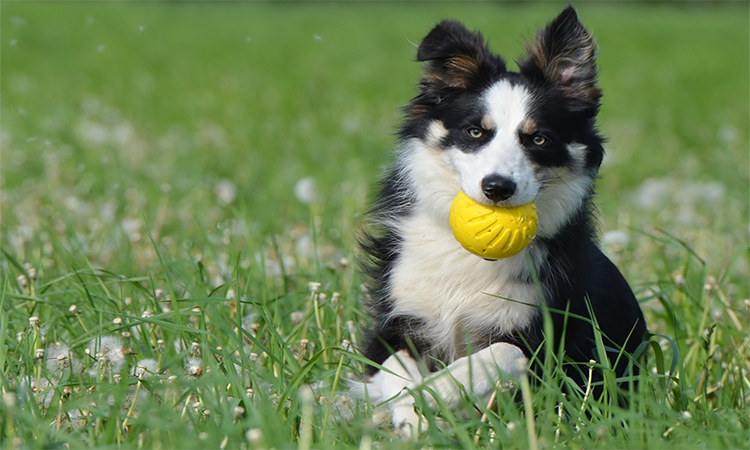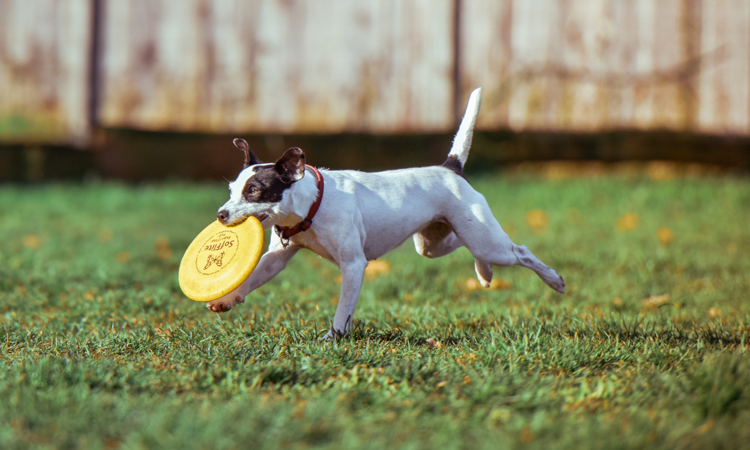Fetch is a classic doggy game that’s lots of fun, great exercise and challenges your dog to learn obedience skills. You might hear some dog owners boast that their dog is born knowing how to fetch and perhaps some are – it certainly seems that some pooches were born to do nothing but fetch all day long. Despite this, some dogs will need more help to learn how to fetch a ball, frisbee or soft toy while out and about.
Chasing a ball or similar airbourne item is one thing, but bringing it back is another story. Some dogs won’t catch on that they, instead of you, should be chasing the ball. The perfect game of fetch involves getting your dog to chase an item, retrieve it, then drop it at your feet again ready to repeat.
In this guide we’ll walk you through how to train your dog to fetch plus all of the other parts that make for a top game of ball or frisbee retrieval.
How to train your dog to fetch

1. Pick a toy for your dog to retrieve
Fetch should be fun and rewarding for both you and your dog. You might begin to find it repetitive but most dogs will love running around retrieving a ball or frisbee for hours on end. Pick a toy that your dog loves and is happy to pick up with their mouth. For some dogs a ball is most suitable, for others it may be a frisbee or another type of soft toy. If your dog seems to have no interest in your object, try a few different variations. Some dogs love tennis balls, while others will only chase foam ones. Who knows why, but all dogs are different and will have different doggy preferences.
2. Get your dog to chase the ball or frisbee
Get your dog interested in the ball or frisbee. Throw it and encourage them to chase it and pick it up. When they pick it up or make any interaction with the toy, praise them.
Hint: for extra motivation hold your dog’s lead or harness while you make the throw. This extra resistance will make them super keen to chase after their ball or frisbee. Once you release them, see how quickly they go after it.
3. Introduce retrieving
Once your dog is reliably chasing after the toy you can introduce retrieval. A game of fetch is not much fun when your dog chases the ball but doesn’t bring it back. Teaching them to retrieve and drop the object at your feet or in your hand will make the game more fun for both of you.
There are two things you can try to get your dog to reliably retrieve items:
a. Reward your dog for dropping the toy
Here’s how it works:
- Once your dog is reliably picking up the toy and looking to you for a reward or treat, withhold the treat until they bring the toy over to you.
- If they begin to walk towards you holding the toy, praise them. As soon as they get near hold out a treat and wait for them to drop the toy so that they can eat the treat, then reward them.
- Once they have the hang of it, you can introduce a command word such as “drop it” before handing over the treat.
b. Swap your toy for another
For dogs who are reluctant to give back the ball they’ve just caught try this approach:
- Take two identical or similar balls out to the park with you.
- Throw one and allow your dog to chase it. Once they have the ball, praise them and turn your body sideways as you begin to move slightly away from your dog. While doing this, use your recall or encourage your dog to move towards you.
- As you dog reaches you, wait to see if they drop the ball. If they don’t, get out the second ball and present it to you dog. They should then release ball one for ball two.
- As soon as the ball falls from your dog’s mouth, throw ball two and pick up the ball they have just dropped.
- Repeat this until your dog is able to return both balls in turn and drop them at your feet.
4. Reinforcement
Once your dog is reliably chasing, retrieving and dropping the ball or frisbee you can reinforce this by practicing lots. You can also ask for more behaviour points before rewarding (for example only giving the treat after they have fetched the ball, returned it, dropped it and have sat waiting for the next throw).
Once your dog has the hang of fetch you can remove the treats altogether and begin to phase out the second ball if you have used that approach.
Common challenges with fetch training

My dog chases the ball but won’t bring it back
In this case try both of the options in step 3, to encourage your dog to work on their retrieval. Take out tasty treats to help and ensure you only reward for the behaviour you want to see, which is bringing the ball back to your feet.
You can also practice on a long line lead, so that when your dog catches the ball you can help them return to you. Whatever you do, never chase your dog to try and retrieve the ball from them, as this will seem like the best game ever and will make them run away more.
My dog drops the ball a few feet away and when I go to pick it up, grabs it and runs away again
In this instance, as your dog is moving towards you begin to back away and say a command such as “closer” or “bring it”. Once your dog gets closer to you (or the original spot), offer a treat for them to drop the ball there.
If your dog still places the ball too far away from you to pick it up, introduce a stand off. By waiting still, exactly where you are and not moving towards your dog or trying to get the ball from them you are using body language to tell your dog that the game stops if they don’t bring back the ball. Eventually, they will realise that the ball needs to be brought to you for the game to continue.
My dog just doesn’t seem interested in fetch like other dogs are?
All dogs are different and like people, they have favourite games and things they like to do. You may find that your dog loves playing fetch at home, but once they get outside become bored or distracted. In this case, you can try and make the game more rewarding by adding in treats or a “work” element such as sniffing out the ball in long grass, or you can not worry about it. Perhaps your dog would prefer to carry a ball or play with other dogs instead?
Have you taught your dog how to fetch? Let us know in the comments below, or share your experience with the DogBuddy community on Facebook Twitter, and in the comments below.